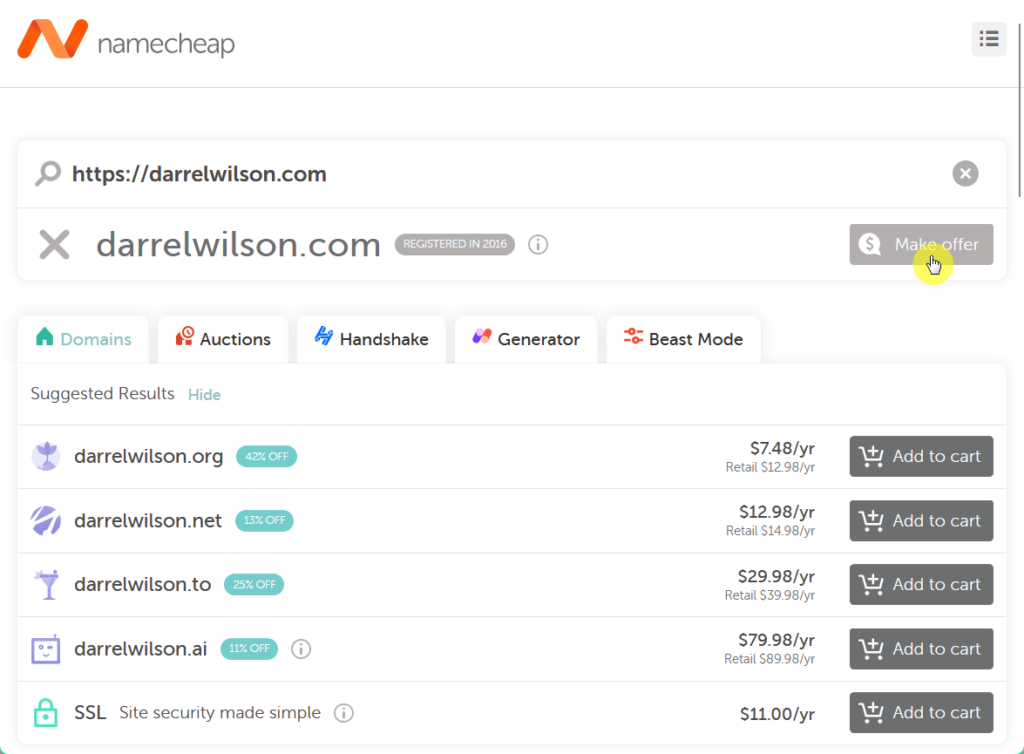


Need a domain name?
By the end of this guide, you will learn how to register a domain name that you can use to create your own website.
Here’s what we’ll cover here:
Ready? Let’s get started.
A domain name is a unique web address where people can find your website, like “example.com” or “darrelwilson.com.”
It serves as a human-friendly way to access online locations, replacing numerical IP addresses with easy-to-remember names.
The domain name system is made up of two main parts:
Having a domain name allows you to control your online presence, including customized email addresses and improved search engine ranking.
A great hosting service can significantly impact your website’s performance, security, and overall user experience.
This is where Hostinger comes in, offering a comprehensive hosting solution made to meet the needs of any website owner.

Discover the Hostinger advantage for your WordPress site:
With Hostinger, you’re not just choosing a hosting provider:
You’re investing in a partner committed to delivering speed, stability, and superior performance for your website.
It’s a simple process that involves choosing a name, checking its availability, and completing the domain registration through any one of the domain registrars.
First of all, you will have to select a domain name.
In choosing a unique domain name, consider the following tips:
Though common, it’s best to avoid using numbers and hyphens as they can be confusing and are usually harder to remember.
It also helps if you think long-term — choose a name that will remain relevant as your business grows and evolves.
You might also want to check the domain providers and see if they have a web hosting service (which might help if you’re short on resources).
There are multiple ways to check who owns a domain name. But for this guide, let’s stick with the WHOIS Lookup website tool of Namecheap.
To start:

You will find here the domain name registrar and information about the domain owner with contact details.
If the domain name you want is taken, get in touch with the domain owners to negotiate a deal.
In Namecheap, there’s an option like this:

You may propose a lower figure if the website appears outdated. However, bid higher for those sites that are frequently updated and have a strong online presence.
While acquiring the domain is always ideal, don’t back down from creativity and brainstorming new domain name ideas if the negotiations falter.
👉 Related: How to Find Out Who Owns a Domain Name: Domain Lookup
A domain registrar serves as an intermediary between you and the organizations that manage domain names online.
Since I already showed you Namecheap, I will be using it here (it’s a well-known domain registrar and web hosting company).
Here are some of its key features:
But take note that there are lots of domain name registrars out there, many have similar features — though not sure why, they sometimes have different prices. 😅
⚠️ Note: Check the web hosting services or hosting providers you’re planning to use since some of them might offer a free domain name.
For this part, all you have to do is repeat step 2 above — go to Namecheap.com and type the domain you want in the search box provided.
Add your desired domain name to your cart and once you’re finished, click on the checkout button in the lower right corner of your screen:

You can see that you may also select additional services like WordPress hosting, SSL certificates, and VPN.
In the next window, review whether your order is accurate — once you’re finished, scroll down to the bottom of the page and click on the confirm order button.
You will then fill up the details as follows:
Congratulations!
Your domain name is now successfully registered, and you’re ready to start building your online presence. 🎉
Having followed these steps, you’re well on your way to a valuable and effective domain name for your website. But this is only the beginning.
To protect your personal information from being publicly available, I highly recommend that you opt for domain privacy services offered by your registrar.
One final note — ensure that your contact information with the registrar is always current and accurate to avoid any issues with domain management or renewal.
Wrapping up, consider the ease and flexibility that comes with using high-quality Elementor template kits.
Darrel Wilson offers an exclusive opportunity to elevate your website design effortlessly.

Secure lifetime access to all premium Elementor template kits:
Level up your website today with Darrel Wilson’s premium Elementor template kits.